First aid should be administered only by trained and authorized personnel who are able to provide a primary assessment and basic medical aid using accessible supplies. Use your next safety meeting as a refresher for trained employees on how to proceed when a colleague may need first aid at work.
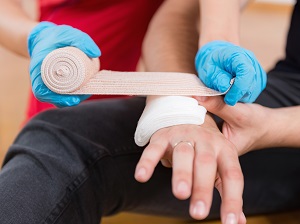
First aid is immediate care provided for injury or sudden illness before emergency medical treatment is available. First aid is typically a one-time, short-term treatment that requires limited medical supplies and only basic training.
Types of First Aid
First aid can include:
- Cleaning minor cuts, scrapes or scratches
- Treating a minor burn
- Applying bandages or dressing
- Assisting with the use of an eyewash station
- Treating a bee sting
- Starting CPR compressions or using an AED
- Responding appropriately to a seizure
- Keeping an injured individual stable until help arrives
OSHA Construction Standard 1926.50(c) In the absence of an infirmary, clinic, hospital, or physician, that is reasonably accessible in terms of time and distance to the worksite, …a person who has a valid certificate in first-aid training shall be available at the worksite to render first aid.
Every medical emergency is different, and the steps taken to assist in any situation involving an injury or illness may vary.
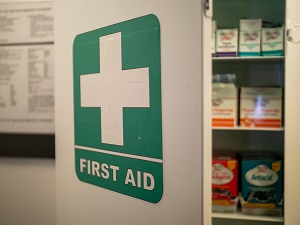
First Aid Supplies
All employees should be familiar with where first aid information and supplies are located in the workplace, including:
- First Aid Kit
- Safety Data Sheets, for information on chemical hazards
- Emergency Action Plan
- Automatic External Defibrillator (AED), if available
OSHA Construction Standard 1926.50(d)(1) First aid supplies shall be easily accessible when required.
For minor conditions, basic first aid care may be enough. For more serious injuries and illnesses, first aid care should be administered, continued and monitored until emergency medical personnel can respond.
Using PPE During First Aid
Using PPE is important to minimize the risk of exposure to bloodborne pathogens. If there is blood or bodily fluids, always wear gloves and protective eyewear when giving first aid care. After providing any type of first aid, wash your hands immediately.
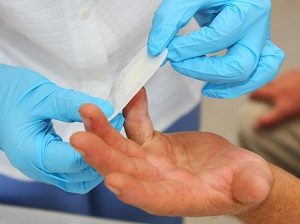
First Aid Steps
To understand the role of first aid in the workplace, consider The Three P’s:
- Preserve Life – the main goal of first aid is to keep the person alive
- Prevent Deterioration – keep the injured person safe and stable until medical professionals arrive
- Promote Recovery – after any initial first aid provided, take steps to aid the recovery process
The first step, in any situation that may require first aid, is to assess the scene. Pause and scan the area to form an initial impression of what happened. Do not enter the scene if it is not safe. If the situation that caused the injury could hurt another person, call 911 (or emergency services) and wait for emergency personnel.
OSHA General Industry Standard 1910.151(b) In the absence of an infirmary, clinic, or hospital in near proximity to the workplace which is used for the treatment of all injured employees, a person or persons shall be adequately trained to render first aid. Adequate first aid supplies shall be readily available.
Before attempting to provide first aid, introduce yourself to the injured or ill person and explain that you are willing to help. Do not touch them until they have granted you permission to assist them. If you encounter someone who is confused or cannot provide permission because they are critically injured or ill, you can assume they would want you to help. This is known as “implied consent.”
If you are taking the lead in providing first aid care on the scene, give orders as appropriate for the situation. When providing directions, point to specific people and speak out loud. Be clear, specific and confident with your commands. You can tell bystanders to perform actions like:
- Bring the AED
- Get the first aid kit
- Call 911, or emergency services
- Stand back
- Stabilize the injured person
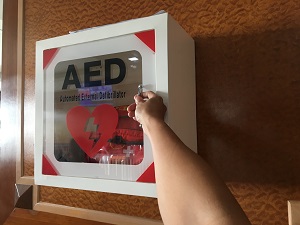
When someone is obviously injured or ill or you are not sure how serious the situation is, call 911 (or emergency services) and remain on the line until help arrives or until the dispatcher tells you to hang up. Emergency system dispatchers can ask you questions to assess the situation and guide you through basic first aid steps and procedures.
If the person is breathing and responsive, ask questions to gather more information about the situation. You can ask questions about the symptoms they are experiencing, known allergies, medication they are currently taking, past medical history, what they’ve had to eat or drink that day and any events that might be relevant to the situation.
After the assessment, with the help of the injured person, the decision can be made to call emergency services or not, depending on the severity of the injury or illness. If emergency personnel does respond, it will be helpful to pass along the information you found while asking these questions.
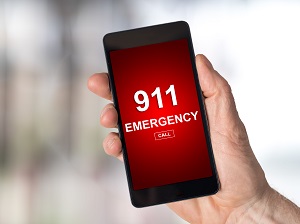
If the person appears unresponsive, attempt to rouse them by shouting, using their name if you know it. If there is no response, tap their shoulder and shout again, while checking for signs of normal breathing. This check for responsiveness and breathing should take no more than 5-10 seconds.
If they are not responsive but are breathing:
- Command bystanders to call 911 (or emergency services) and retrieve the first aid kit, and the AED, if available.
- Gather information from bystanders using the SAMPLE questions.
- Conduct a head-to-toe check for injuries.
- Roll the person onto their side into a recovery position if there are no obvious signs of injury and wait for emergency medical personnel.
If they are not breathing:
- Command bystanders to call 911 (or emergency services) and retrieve the first aid kit, and the AED, if available.
- Ensure the injured person is laying face-up on a firm, flat surface such as the floor.
- If you are trained to do so, begin CPR, starting with compressions, or use an AED, if available.
- Continue CPR until 1) the person starts breathing, or 2) an AED becomes available, or 3) it becomes unsafe to continue, or 4) emergency personnel arrive on the scene.
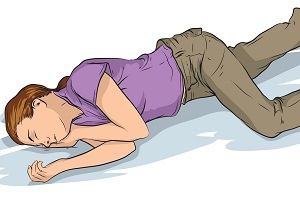
.jpg)

